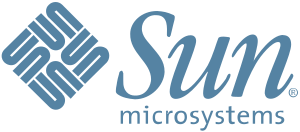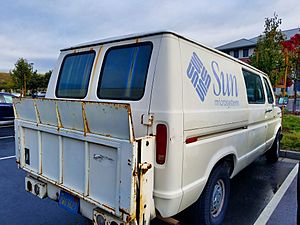Acquisition of Sun Microsystems by Oracle Corporation facts for kids
 |
|
| Initiator | Oracle Corporation |
|---|---|
| Target | Sun Microsystems |
| Type | Full acquisition |
| Cost | $7.4 billion (value) $5.4 billion (net cash / debt) |
| Initiated | April 20, 2009 |
| Completed | January 27, 2010 |
On January 27, 2010, a big computer company called Oracle Corporation bought another major tech company, Sun Microsystems. Before this, Oracle mostly sold computer programs (software). Sun Microsystems, however, made both computer hardware (like servers) and important software, including the Java programming language.
After Oracle bought Sun, Oracle became a company that sold both software and hardware. This deal was worth about $7.4 billion. Some people, including groups that watch out for fair competition, worried about this takeover. They were especially concerned about what would happen to MySQL, a popular free database program that Sun owned. MySQL was a competitor to Oracle's own database program.
Contents
- How the Deal Happened
- Key People Left Sun
- Changes to OpenSolaris and Solaris
- MySQL Concerns and New Versions
- Java Android Lawsuit
- Apache Software Foundation Leaves Java Committee
- OpenOffice Changes and New Versions
- Hudson and Jenkins Split
- Grid Engine Becomes Commercial
- Other Project Closures
- Customer Support Changes
- Virtualization Technologies
- Images for kids
How the Deal Happened
In late 2008, Sun Microsystems was looking for a buyer. They talked with IBM and another company, possibly HP. But by March 2009, these talks didn't go anywhere.
On April 20, 2009, Sun and Oracle announced they had agreed on a deal. Oracle would buy Sun for $9.50 per share. Sun's shareholders (people who owned parts of the company) agreed to the plan on July 16, 2009. However, the deal still needed approval from governments in many countries. These approvals make sure that big company mergers don't harm competition.
On August 20, 2009, the United States government approved Oracle's purchase of Sun. But on September 3, 2009, the European Commission (a group that oversees competition in Europe) said they needed more time to investigate. They were worried about Oracle owning MySQL, which was a free and open-source database.
Because of these delays, Sun Microsystems had to cut about 3,000 jobs. Their income also dropped because customers were unsure about the company's future. Finally, on January 21, 2010, the European Commission gave its approval. Oracle officially completed the acquisition on January 27, 2010.
Key People Left Sun
After Oracle bought Sun, many important engineers and leaders left the company. These included:
- James Gosling, who created the Java programming platform. He left in April 2010.
- Tim Bray, who helped create XML, a way to organize information online. He left in February 2010.
- Kohsuke Kawaguchi, the main developer of a software tool called Hudson. He left in April 2010.
- Bryan Cantrill, who helped create DTrace, a tool for finding problems in computer systems. He left in July 2010.
Other teams also left Sun before or after the acquisition. For example, the JRuby team moved to a different company called Engine Yard. The Drizzle DBMS team moved to Rackspace. Most of Sun's top managers, including CEO Jonathan Schwartz, also resigned.
Changes to OpenSolaris and Solaris
After the acquisition, people started to worry about the future of OpenSolaris, a free and open-source version of Sun's Solaris operating system.
In August 2010, it became clear that Oracle would no longer release new versions of OpenSolaris. Oracle also decided to stop sharing the Solaris source code (the basic instructions for the program) as it was being developed. Instead, they would only release it after each new version of Solaris was finished. Because of this, the group that managed OpenSolaris decided to stop the project. However, independent developers continued the work by creating a new version called Illumos.
In 2017, reports said that Oracle had laid off almost all of its Solaris development staff. This suggested that Oracle might not plan to continue developing Solaris much in the future.
MySQL Concerns and New Versions
One of the biggest concerns during the acquisition was Oracle's control over MySQL. MySQL is a popular free and open-source database program that Sun had bought in 2008. Many people worried that Oracle, which had its own competing database, might not support MySQL well.
To ensure MySQL's future, some developers created new versions, or "forks," of the program. These include Drizzle (which is no longer developed) and MariaDB (which is still actively developed). Monty Widenius, one of the creators of MySQL, even started a petition asking Oracle to sell MySQL to another company or change its licensing rules to be more open.
Java Android Lawsuit
Oracle also filed a lawsuit against Google because Google used parts of Java in its Android mobile phone platform. Android apps are written in Java, but they run on a special system called Dalvik. Google did this to avoid paying licensing fees for Java's mobile version. However, Oracle claimed that parts of Dalvik were too similar to Java technology that Sun (and now Oracle) had patented.
The court case was long and complicated. At first, a court said that Google hadn't copied enough to break copyright laws. But later, an appeals court disagreed. They said that the way Java's parts were organized could be protected by copyright. In 2016, a jury decided that Google's use was fair under copyright law. But in 2018, another appeals court ruled that Google had indeed violated copyright laws. The court stated that using a copyrighted work exactly for the same purpose on a competing platform was not fair.
Apache Software Foundation Leaves Java Committee
The Apache Software Foundation is a group that supports many open-source software projects. They left a committee that guides the development of Java. They did this because Oracle refused to give them a special kit (called a TCK) needed to make sure their own open-source version of Java, called Apache Harmony, worked correctly.
OpenOffice Changes and New Versions
After Oracle stopped supporting OpenSolaris, some members of the OpenOffice.org project also became worried. OpenOffice.org was a popular free office software suite. These members formed a new group called The Document Foundation and created a new version of the software called LibreOffice. They hoped Oracle would join them and give them the OpenOffice.org brand name.
Instead, Oracle asked members of the OpenOffice.org Community Council who were involved with The Document Foundation to step down. Many community members then left to work on LibreOffice, which gained support from other big tech companies like Red Hat and Google. LibreOffice released its first version in January 2011.
In June 2011, Oracle gave the OpenOffice.org brand and its source code to the Apache Software Foundation. Apache then released it under a different open-source license. IBM also contributed its own office software, Lotus Symphony, to the Apache project, which helped create Apache OpenOffice.
Hudson and Jenkins Split
In late 2010, there was a disagreement within the Hudson software community about how the project was managed by Oracle. Oracle claimed the "Hudson" name and applied for a trademark. Because of this, the main developers decided to change the project's name to "Jenkins." Most of the community voted for this change.
On February 1, 2011, Oracle said they would continue developing Hudson, and they considered Jenkins a separate project, or "fork." So, Hudson and Jenkins became two independent projects, both doing similar things.
Grid Engine Becomes Commercial
Oracle Grid Engine (which used to be called Sun Grid Engine) was changed from an open-source program to a closed-source, commercial-only product. This means people now have to pay to use it.
Other Project Closures
- Project Kenai, a website for Java software projects, was moved to Java.net by Oracle.
- Project Darkstar, a project that explored solutions for large online games, was completely shut down by Oracle on February 2, 2010.
Customer Support Changes
Oracle changed its rules for software support. Now, if you want technical support for Oracle software, you also have to pay for support for all your hardware systems.
Also, in March 2010, the free download license for Solaris 10 was changed. People could only use it for free for 90 days.
Virtualization Technologies
In 2013, Oracle stopped developing several virtualization tools that came from Sun. These included Virtual Desktop Infrastructure (VDI), Sun Ray, and Oracle Virtual Desktop Client. However, two other virtualization technologies from Sun, Oracle Secure Global Desktop and VirtualBox, continued to be developed and sold by Oracle.
Images for kids



